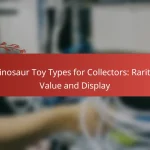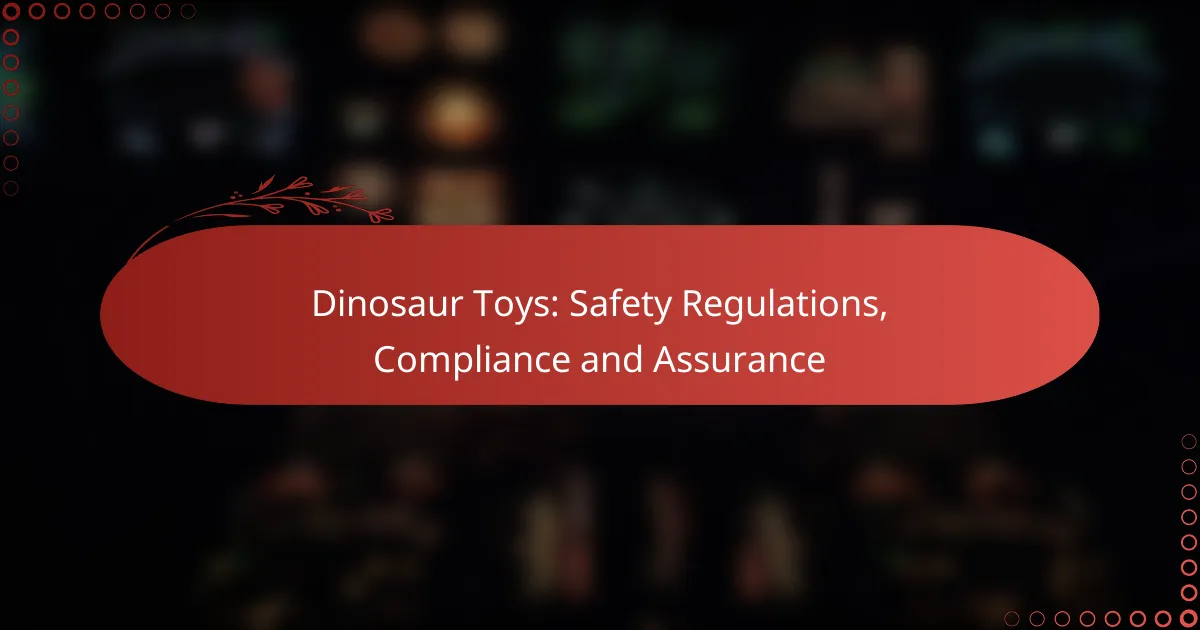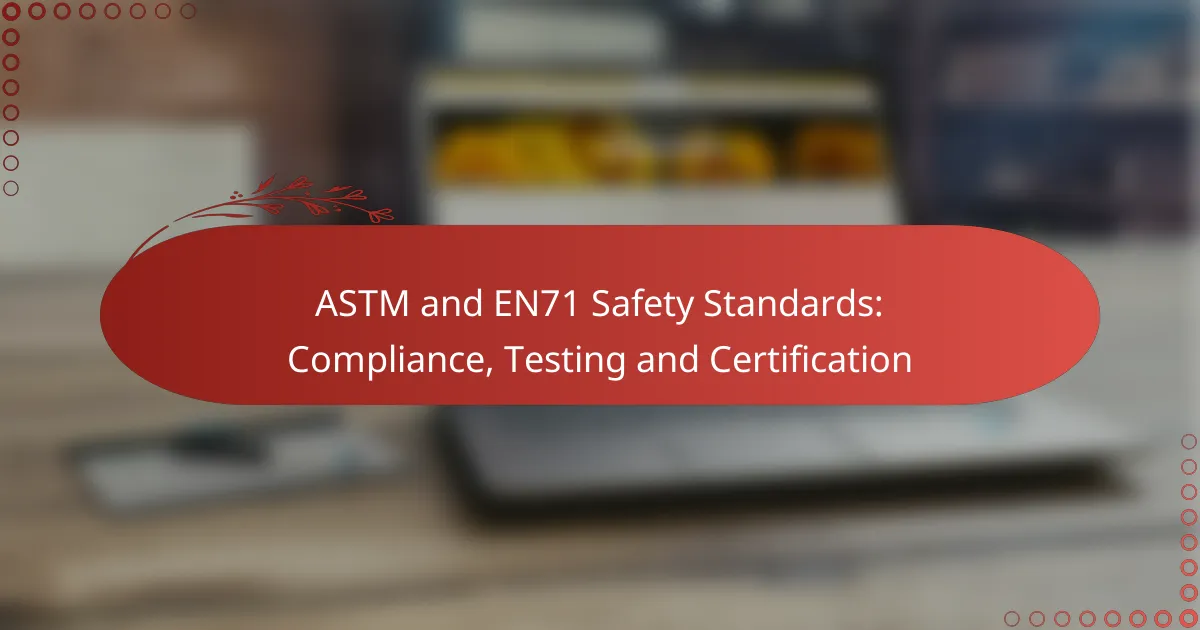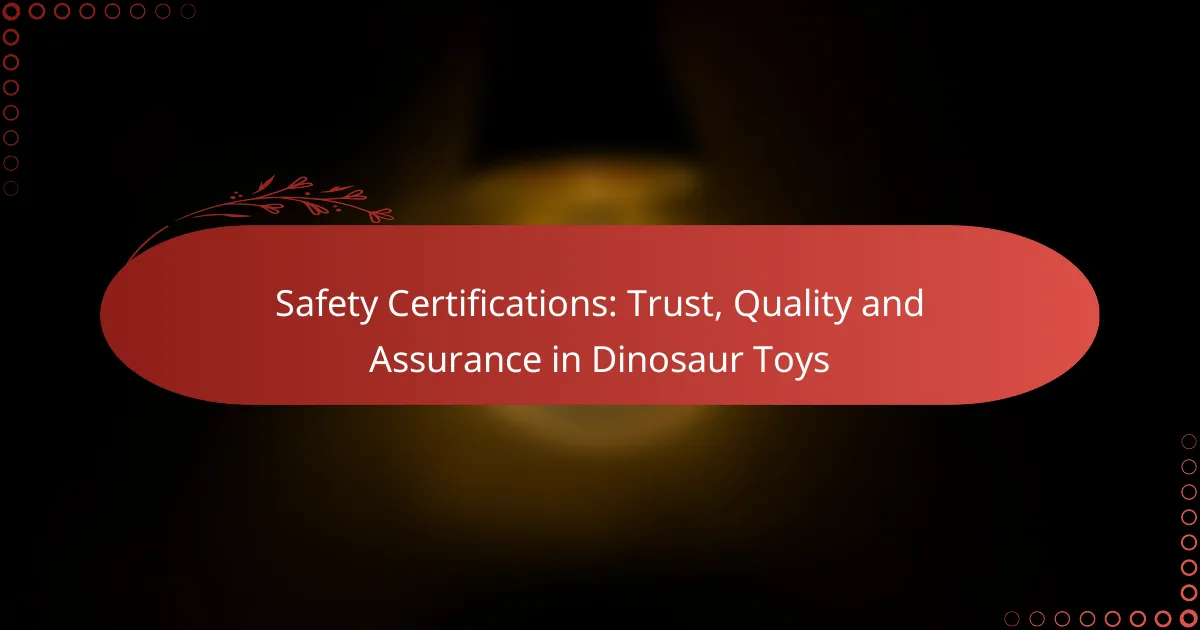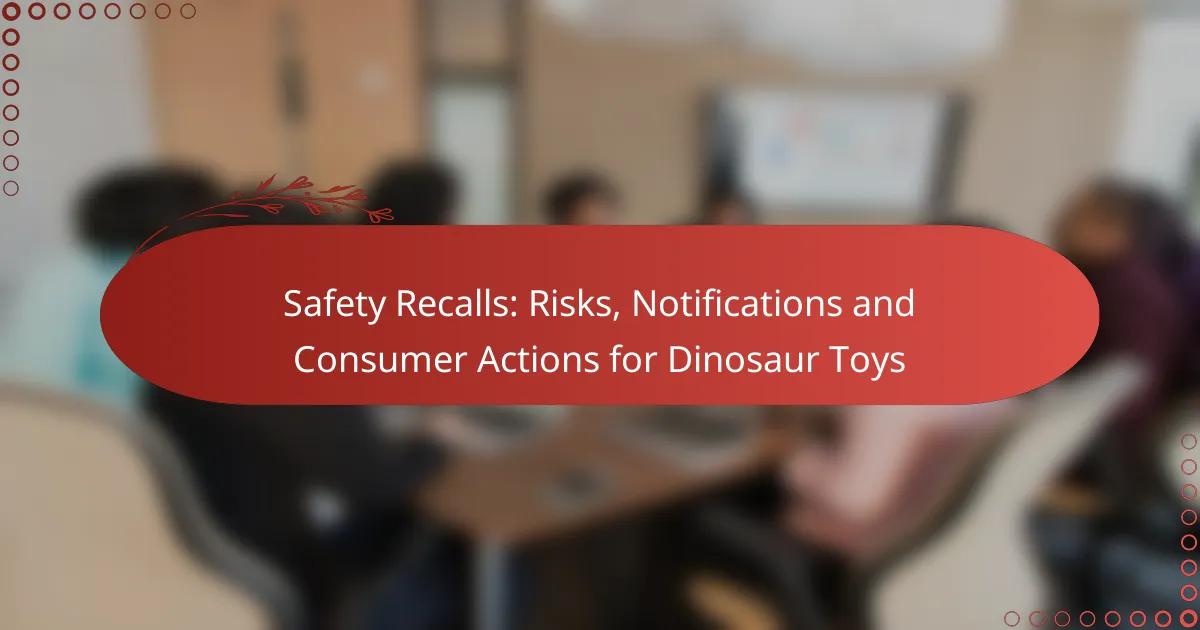Dinosaur toys are subject to stringent safety regulations in the US to guarantee their safety for children. Compliance with ASTM F963 standards and guidelines from the CPSC, along with state-specific laws, is essential for manufacturers to ensure their products meet safety requirements. By following best practices in material selection, design, and thorough testing, manufacturers can uphold quality assurance and protect young users.
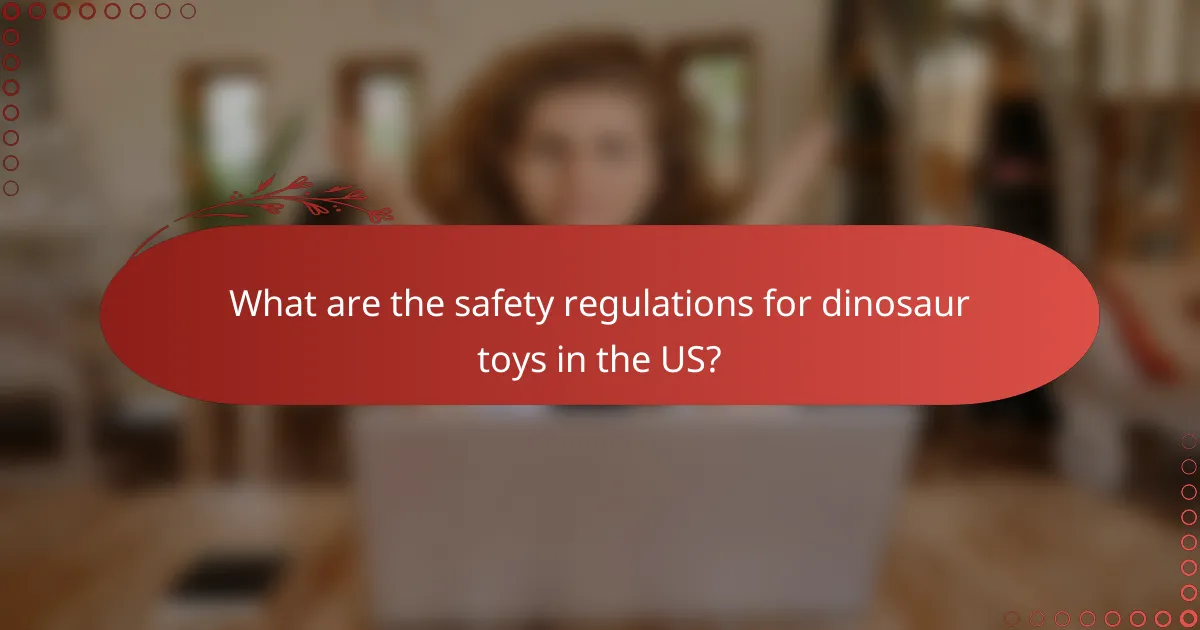
What are the safety regulations for dinosaur toys in the US?
In the US, dinosaur toys must adhere to specific safety regulations to ensure they are safe for children. These regulations include compliance with ASTM F963 standards, guidelines set by the CPSC, and various state-specific laws that may impose additional requirements.
ASTM F963 compliance
ASTM F963 is a widely recognized standard for toy safety in the United States, focusing on mechanical and physical properties, flammability, and toxic substances. Dinosaur toys must pass tests for sharp edges, small parts, and other hazards to prevent injuries to children.
Manufacturers should ensure that their products are tested by certified laboratories to confirm compliance with ASTM F963. Regular audits and quality checks can help maintain adherence to these standards throughout the production process.
CPSC guidelines
The Consumer Product Safety Commission (CPSC) oversees the safety of toys, including dinosaur figures. The CPSC enforces regulations that require toys to be free from hazardous materials and to meet specific labeling requirements, such as age grading and safety warnings.
To comply with CPSC guidelines, manufacturers should conduct thorough risk assessments and keep detailed records of testing and compliance. This proactive approach can help avoid recalls and ensure consumer trust in their products.
State-specific regulations
In addition to federal regulations, some states have their own specific safety requirements for toys. For example, California has stringent regulations regarding the presence of certain chemicals in toys, which can affect the manufacturing process for dinosaur toys sold in that state.
Manufacturers should stay informed about state-specific regulations where their products are sold. This may involve additional testing or labeling to meet local laws, ensuring that all toys are compliant and safe for children in those markets.
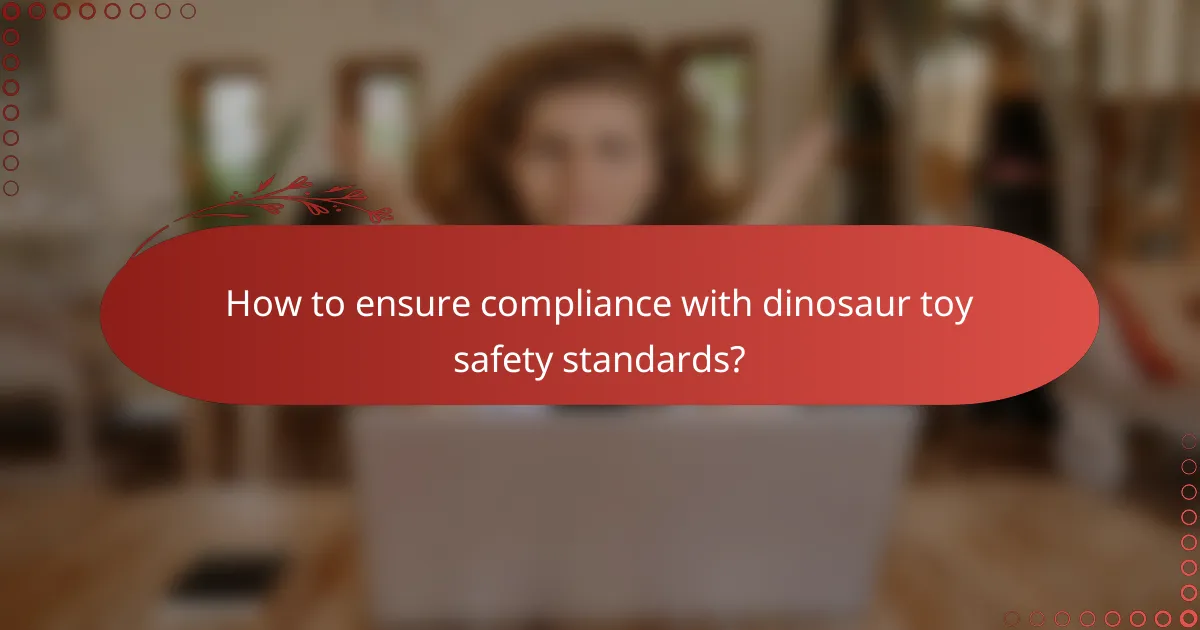
How to ensure compliance with dinosaur toy safety standards?
To ensure compliance with dinosaur toy safety standards, manufacturers must adhere to established regulations and conduct thorough testing. This includes understanding relevant safety guidelines, performing safety assessments, and maintaining proper documentation throughout the production process.
Conducting safety testing
Safety testing for dinosaur toys involves evaluating materials, design, and functionality to ensure they meet safety standards. Tests should include assessments for choking hazards, sharp edges, and toxic substances. It is advisable to conduct these tests in accredited laboratories that specialize in toy safety.
Common tests include mechanical safety tests, chemical analysis for harmful substances, and age-appropriateness evaluations. Regular testing throughout the production cycle can help identify potential issues early, reducing the risk of recalls or safety incidents.
Documentation and labeling requirements
Proper documentation is essential for compliance with safety standards for dinosaur toys. Manufacturers must maintain records of safety tests, material specifications, and production processes. This documentation should be readily available for inspection by regulatory bodies.
Labeling is equally important; toys must include clear age recommendations, safety warnings, and compliance marks. Labels should be durable and legible, ensuring that consumers can easily understand the safety information provided. Adhering to these documentation and labeling requirements helps build trust with consumers and regulatory authorities alike.

What are the best practices for dinosaur toy manufacturers?
Best practices for dinosaur toy manufacturers focus on ensuring safety, compliance with regulations, and quality assurance throughout the production process. This involves careful selection of materials, thoughtful design considerations, and adherence to safety standards to protect children and meet market demands.
Material selection
Choosing the right materials is crucial for dinosaur toy manufacturers to ensure safety and durability. Non-toxic plastics, such as ABS or PVC, are commonly used, but manufacturers should verify that these materials comply with safety standards like ASTM F963 in the United States or EN71 in Europe.
Additionally, manufacturers should consider the potential for small parts that could pose choking hazards. Using larger components and avoiding detachable small parts can help mitigate this risk. Regular testing for harmful substances, such as phthalates and lead, is essential to maintain compliance and consumer trust.
Design considerations
Design plays a significant role in the safety and appeal of dinosaur toys. Rounded edges and smooth surfaces should be prioritized to prevent injuries. Toys should be designed to withstand rough play, which is typical for children, ensuring they do not break easily and create sharp edges.
Moreover, incorporating bright colors and engaging features can enhance the toy’s attractiveness without compromising safety. Manufacturers should also consider age-appropriateness in their designs, ensuring that toys are suitable for the intended age group, which can help avoid safety issues related to small parts or complex mechanisms.

What are the risks associated with non-compliance?
Non-compliance with safety regulations for dinosaur toys can lead to significant risks, including legal consequences and harm to a company’s reputation. These risks can affect manufacturers, retailers, and consumers alike, making adherence to safety standards crucial.
Legal penalties
Manufacturers and retailers of dinosaur toys face various legal penalties for non-compliance with safety regulations. These can include hefty fines, product recalls, and even lawsuits from consumers or regulatory bodies. For instance, fines can range from hundreds to thousands of dollars depending on the severity of the violation.
In some jurisdictions, repeated non-compliance can lead to more severe consequences, such as the suspension of business licenses or criminal charges against responsible individuals. It’s essential for companies to stay informed about local laws and regulations to avoid these legal pitfalls.
Reputation damage
Non-compliance can severely damage a company’s reputation, leading to loss of consumer trust and decreased sales. Once a brand is associated with unsafe products, it can take years to rebuild that trust, if it can be rebuilt at all. Consumers are increasingly aware of safety standards and may choose competitors over brands with compliance issues.
Additionally, negative media coverage and online reviews can amplify reputation damage, affecting not just current sales but also future business opportunities. Companies should prioritize compliance not only to avoid penalties but also to maintain a positive public image.

How can consumers verify the safety of dinosaur toys?
Consumers can verify the safety of dinosaur toys by checking for certification marks and researching the manufacturers. These steps ensure that the toys meet safety standards and are made from non-toxic materials.
Checking for certification marks
Certification marks indicate that a toy has been tested and meets specific safety standards. Look for marks from recognized organizations such as ASTM International or the Consumer Product Safety Commission (CPSC) in the United States.
When examining dinosaur toys, ensure the certification is current and relevant to your region. For example, toys sold in the European Union should have the CE mark, indicating compliance with EU safety regulations.
Researching manufacturers
Investigating the manufacturers of dinosaur toys can provide insight into their safety practices and reputation. Look for companies that have a history of producing safe toys and are transparent about their materials and testing processes.
Check online reviews and consumer reports to gauge the experiences of other buyers. Additionally, visit the manufacturer’s website to find information about their safety policies and any certifications they hold.

What are the emerging trends in dinosaur toy safety?
Emerging trends in dinosaur toy safety focus on using sustainable materials and integrating advanced technology to enhance child safety. These developments aim to meet regulatory standards while providing parents with peace of mind regarding their children’s playtime.
Eco-friendly materials
Eco-friendly materials are becoming increasingly popular in the production of dinosaur toys. Manufacturers are opting for biodegradable plastics, organic fabrics, and non-toxic paints to ensure safety and sustainability. These materials not only reduce environmental impact but also minimize the risk of harmful chemicals coming into contact with children.
When selecting dinosaur toys, look for certifications such as ASTM or EN71, which indicate compliance with safety standards. Additionally, consider toys made from recycled materials, as they often meet safety regulations while promoting environmental responsibility.
Smart toy technology
Smart toy technology is revolutionizing the way children interact with dinosaur toys, enhancing both safety and educational value. These toys often include features like app connectivity, voice recognition, and interactive learning experiences, which can help monitor playtime and ensure safe usage.
Parents should be aware of the importance of data privacy when choosing smart toys. Look for products that clearly state their data protection policies and ensure they comply with regulations such as COPPA in the U.S. or GDPR in Europe. This helps safeguard children’s information while allowing them to enjoy the benefits of modern technology.


